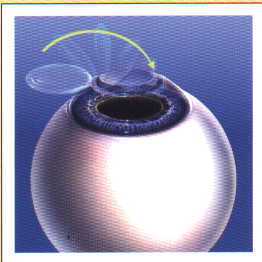Christopher
Yo M.D., Ph.D.
BiographyNearsightedness, Farsightedness &
Astigmatism
Laser
Vision Correction
PRK
LASIK
Am
I A Candidate?
Home
|
Laser
Assisted In-Situ Keratomileusis (LASIK)
LASIK
utilizes the same laser used for PRK except treatment is
not applied to the surface of the cornea. The laser
treatment is applied to the inner part of the cornea
after a superficial corneal flap is lifted with an
automated device. After the pre-programmed laser
treatment, the superficial corneal flap is placed back
into the original position. The benefit of this procedure
over PRK is less discomfort after surgery and faster
visual recovery. Many patients return to work the next
day.
Disadvantages of
LASIK
- Dry eye syndrom after surgery.
- Complications
with corneal flap can occur if patient rubs the
eye very hard after surgery. If the cap is misaligned, then another operation to re-adjust it may be necessary.
- Infections.
- Epithelial ingrowth.
- Diffuse lamella keratitis (1%). If identified on the first postoperative day can be treated appropriately to prevent patients from developing permanent loss of vision. DLK is the term used to describe nonspecific inflammatory reactions in the lamellar interface following LASIK.
Although the exact cause of DLK is unknown, the condition follows a predictable time course. Potential causes of DLK are contaminates such as oil, metallic fragments, silicates, bacterial endotoxins, and betadine.
- If
corneal flap is cut imperfectly, need to wait
three months, let it heal before attempting
surgery again
Advantages of LASIK
- Able
to treat high amounts of near sightedness, far sightedness, and astigmatism.
- Minimal
pain post-operatively
- Minimal
corneal haze
- Retreatment can be done easily within the first two months by lifting the corneal flap and adding more laser pulses to the corneal bed.
|


